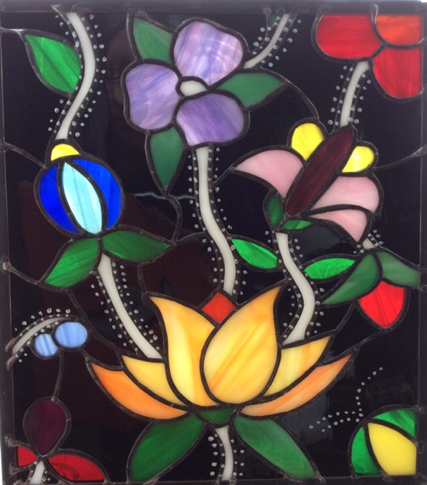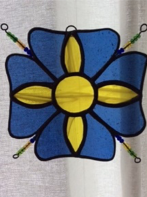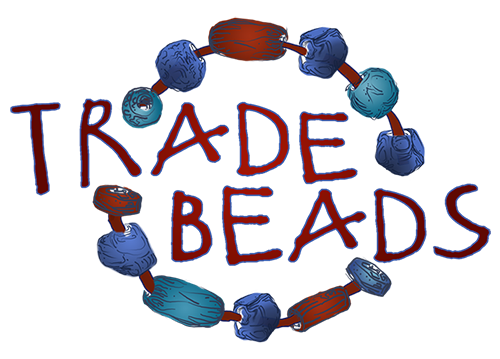Welcome to the Métis Women's Circle Blog. Articles are written by members of the Circle and are on a variety of topics. Submissions from our members are welcome. See our Guidelines below for more submission information.
The Flower Beadwork People
Linda Cauchy
Métis Women's Circle
May 12, 2021
Since moving to the country and living close to the land, I see the beauty that is present everywhere. Sometimes though, this beauty is hidden from my view through distractions of everyday life. In our hurried urban lives it is all too easy to miss the small daisy or the field of Queen Anne's lace as we zoom by on the highway. I marvel at how our Métis ancestors captured, through their beadwork, the beauty of the prairie flowers in spite of the hardship they faced.
 Métis life in the 1800s was not an easy one; hunters, traders, middlemen, Métis were often overlooked and faced discrimination by both First Nations and white colonist society. Through political maneuvers, land was stolen and trade livelihood denied. My elders tell me life was full of rigours yet the Métis women celebrated the prairie beauty in sophisticated beadwork and embroidery, decorating moccasins, tobacco pouches, horse saddles, vests, belts, dog blankets; everything they could get their hands on! Through our bead work, we Métis became known as the Flower Beadwork People. The researcher Kisha Supernant described the Métis worldview as one where the nature/culture divide did not exist (https://www.oxfordhandbooks.com/view/10.1093/oxfordhb/9780199935413.001.0001/oxfordhb-9780199935413-e-70"). I see this syncretic worldview expressed through elaborately beaded everyday items through the use of an explosion of colour!
Métis life in the 1800s was not an easy one; hunters, traders, middlemen, Métis were often overlooked and faced discrimination by both First Nations and white colonist society. Through political maneuvers, land was stolen and trade livelihood denied. My elders tell me life was full of rigours yet the Métis women celebrated the prairie beauty in sophisticated beadwork and embroidery, decorating moccasins, tobacco pouches, horse saddles, vests, belts, dog blankets; everything they could get their hands on! Through our bead work, we Métis became known as the Flower Beadwork People. The researcher Kisha Supernant described the Métis worldview as one where the nature/culture divide did not exist (https://www.oxfordhandbooks.com/view/10.1093/oxfordhb/9780199935413.001.0001/oxfordhb-9780199935413-e-70"). I see this syncretic worldview expressed through elaborately beaded everyday items through the use of an explosion of colour!
Our Métis beading styles evolved from many close relationships with traditional Anishinaabe/Cree motifs and materials blended with European embroidery techniques. European glass beads were eventually added. Through archeological research on Métis material culture at known prairie Métis overwintering sites, glass beads far outnumbered other materials, such as household items or building materials. This finding underscores the value and importance of beading (https://www.oxfordhandbooks.com/view/10.1093/oxfordhb/9780199935413.001.0001/oxfordhb-9780199935413-e-70).
As the beading art form evolved, so did its monetary value. The savvy Métis people of the time were well aware of markets and commerce and knew how to conduct business. Métis beadwork was often sold to Treaty people (First Nations groups) and then resold to other consumers as "real Indian" beadwork. This led to widespread misidentification of Métis beadwork. Traditional income sources of beaver trade and buffalo hunting were disappearing while growing colonial populations created demand for beaded materials through tourist trade. (http://www.Métismuseum.ca/media/document/php/00715.BeadworkQuillworkEm.pdf)
In recent years, traditional Métis beadwork has seen a resurgence as we yearn to reconnect with our Métis heritage. Men and women alike are drawn to the challenge and beauty of Métis beadwork. Lisa Shepherd is an accomplished beadwork artist. Her work can be viewed at lisashepherd.ca. She says,
 Being an earnest Métis, I have attempted beading and have found that I either lack the patience or the talent (perhaps both!) to accomplish even the smallest of flowers. Though, as a stained glass artist I've begun to explore beading motifs through copper foil techniques. Before cutting any glass I learned that Métis beadwork often incorporates elements of four: four stages of a plant as stems, leaves, buds, flowers; four quadrants in a design. The flowers we see in the beadwork are representations of native prairie wildflowers such as the prairie crocus (anemone patens), wild strawberry (fragaria glauca), western red lily (lilium philadelphicum), hoary puccoon (lithospernum canescens), blue eyed grass (sisyrinchium montanum); the list goes on. Unlike traditional glass beads, art glass is an unforgiving medium through which to express fluid, organic motifs. But I am inspired by the history, richness of design, creativity and a desire to honour Métis beadworkers to create works that keep Métis traditions alive.
Being an earnest Métis, I have attempted beading and have found that I either lack the patience or the talent (perhaps both!) to accomplish even the smallest of flowers. Though, as a stained glass artist I've begun to explore beading motifs through copper foil techniques. Before cutting any glass I learned that Métis beadwork often incorporates elements of four: four stages of a plant as stems, leaves, buds, flowers; four quadrants in a design. The flowers we see in the beadwork are representations of native prairie wildflowers such as the prairie crocus (anemone patens), wild strawberry (fragaria glauca), western red lily (lilium philadelphicum), hoary puccoon (lithospernum canescens), blue eyed grass (sisyrinchium montanum); the list goes on. Unlike traditional glass beads, art glass is an unforgiving medium through which to express fluid, organic motifs. But I am inspired by the history, richness of design, creativity and a desire to honour Métis beadworkers to create works that keep Métis traditions alive.
 As Métis artists, we cherish Louis Riel's prophetic words, "My people will sleep for one hundred years, but when they awake, it will be the artists who give them their spirit back" (http://www.mmf.mb.ca/louis_riel_quotes.php").
Long live the Flower Beadwork People.
As Métis artists, we cherish Louis Riel's prophetic words, "My people will sleep for one hundred years, but when they awake, it will be the artists who give them their spirit back" (http://www.mmf.mb.ca/louis_riel_quotes.php").
Long live the Flower Beadwork People.
Meegwetch.
The Flower Beadwork People
Linda Cauchy
Métis Women's Circle
May 12, 2021
Since moving to the country and living close to the land, I see the beauty that is present everywhere. Sometimes though, this beauty is hidden from my view through distractions of everyday life. In our hurried urban lives it is all too easy to miss the small daisy or the field of Queen Anne's lace as we zoom by on the highway. I marvel at how our Métis ancestors captured, through their beadwork, the beauty of the prairie flowers in spite of the hardship they faced.
 Métis life in the 1800s was not an easy one; hunters, traders, middlemen, Métis were often overlooked and faced discrimination by both First Nations and white colonist society. Through political maneuvers, land was stolen and trade livelihood denied. My elders tell me life was full of rigours yet the Métis women celebrated the prairie beauty in sophisticated beadwork and embroidery, decorating moccasins, tobacco pouches, horse saddles, vests, belts, dog blankets; everything they could get their hands on! Through our bead work, we Métis became known as the Flower Beadwork People. The researcher Kisha Supernant described the Métis worldview as one where the nature/culture divide did not exist (https://www.oxfordhandbooks.com/view/10.1093/oxfordhb/9780199935413.001.0001/oxfordhb-9780199935413-e-70"). I see this syncretic worldview expressed through elaborately beaded everyday items through the use of an explosion of colour!
Métis life in the 1800s was not an easy one; hunters, traders, middlemen, Métis were often overlooked and faced discrimination by both First Nations and white colonist society. Through political maneuvers, land was stolen and trade livelihood denied. My elders tell me life was full of rigours yet the Métis women celebrated the prairie beauty in sophisticated beadwork and embroidery, decorating moccasins, tobacco pouches, horse saddles, vests, belts, dog blankets; everything they could get their hands on! Through our bead work, we Métis became known as the Flower Beadwork People. The researcher Kisha Supernant described the Métis worldview as one where the nature/culture divide did not exist (https://www.oxfordhandbooks.com/view/10.1093/oxfordhb/9780199935413.001.0001/oxfordhb-9780199935413-e-70"). I see this syncretic worldview expressed through elaborately beaded everyday items through the use of an explosion of colour!Our Métis beading styles evolved from many close relationships with traditional Anishinaabe/Cree motifs and materials blended with European embroidery techniques. European glass beads were eventually added. Through archeological research on Métis material culture at known prairie Métis overwintering sites, glass beads far outnumbered other materials, such as household items or building materials. This finding underscores the value and importance of beading (https://www.oxfordhandbooks.com/view/10.1093/oxfordhb/9780199935413.001.0001/oxfordhb-9780199935413-e-70).
As the beading art form evolved, so did its monetary value. The savvy Métis people of the time were well aware of markets and commerce and knew how to conduct business. Métis beadwork was often sold to Treaty people (First Nations groups) and then resold to other consumers as "real Indian" beadwork. This led to widespread misidentification of Métis beadwork. Traditional income sources of beaver trade and buffalo hunting were disappearing while growing colonial populations created demand for beaded materials through tourist trade. (http://www.Métismuseum.ca/media/document/php/00715.BeadworkQuillworkEm.pdf)
In recent years, traditional Métis beadwork has seen a resurgence as we yearn to reconnect with our Métis heritage. Men and women alike are drawn to the challenge and beauty of Métis beadwork. Lisa Shepherd is an accomplished beadwork artist. Her work can be viewed at lisashepherd.ca. She says,
"I am a Canadian who knows that Art documents our story. I am an Artist who respects how our story touches our hearts, and how healing begins with our understanding. I am a Woman who gently acknowledges that this understanding is powerful. The past, the present and the future reverberates along my thread."(https://www.lisashepherd.ca/)Another contemporary lifelong beadwork artist, Jennine Krauchi, created her commissioned twenty six foot tall fire bag (aka octopus bag) which is featured in the Canadian Museum for Human Rights located in Winnipeg. Krauchi comments on Métis beadwork saying that historically, beadwork had a distinctive regional style; you could tell where the beadwork came from. Some will add, even the beader could be identified.
 Being an earnest Métis, I have attempted beading and have found that I either lack the patience or the talent (perhaps both!) to accomplish even the smallest of flowers. Though, as a stained glass artist I've begun to explore beading motifs through copper foil techniques. Before cutting any glass I learned that Métis beadwork often incorporates elements of four: four stages of a plant as stems, leaves, buds, flowers; four quadrants in a design. The flowers we see in the beadwork are representations of native prairie wildflowers such as the prairie crocus (anemone patens), wild strawberry (fragaria glauca), western red lily (lilium philadelphicum), hoary puccoon (lithospernum canescens), blue eyed grass (sisyrinchium montanum); the list goes on. Unlike traditional glass beads, art glass is an unforgiving medium through which to express fluid, organic motifs. But I am inspired by the history, richness of design, creativity and a desire to honour Métis beadworkers to create works that keep Métis traditions alive.
Being an earnest Métis, I have attempted beading and have found that I either lack the patience or the talent (perhaps both!) to accomplish even the smallest of flowers. Though, as a stained glass artist I've begun to explore beading motifs through copper foil techniques. Before cutting any glass I learned that Métis beadwork often incorporates elements of four: four stages of a plant as stems, leaves, buds, flowers; four quadrants in a design. The flowers we see in the beadwork are representations of native prairie wildflowers such as the prairie crocus (anemone patens), wild strawberry (fragaria glauca), western red lily (lilium philadelphicum), hoary puccoon (lithospernum canescens), blue eyed grass (sisyrinchium montanum); the list goes on. Unlike traditional glass beads, art glass is an unforgiving medium through which to express fluid, organic motifs. But I am inspired by the history, richness of design, creativity and a desire to honour Métis beadworkers to create works that keep Métis traditions alive. As Métis artists, we cherish Louis Riel's prophetic words, "My people will sleep for one hundred years, but when they awake, it will be the artists who give them their spirit back" (http://www.mmf.mb.ca/louis_riel_quotes.php").
Long live the Flower Beadwork People.
As Métis artists, we cherish Louis Riel's prophetic words, "My people will sleep for one hundred years, but when they awake, it will be the artists who give them their spirit back" (http://www.mmf.mb.ca/louis_riel_quotes.php").
Long live the Flower Beadwork People.Meegwetch.
Posted
ARCHIVE
| March 27, 2024 | Trees are Good Medicine |
| January 24, 2024 | The Enduring Impacts of Colonial Violence |
| September 25, 2023 | Loon Summer |
| April 29, 2022 | To Apologize |
| April 28, 2022 | Developing Healthy Water Routines |
| April 25, 2022 | Water is Not a Noun |
| May 12, 2021 | The Flower Beadwork People |
| May 1, 2021 | Good Riddance Beyak |
| April 1, 2021 | Another Day in Paradise |
| March 1, 2021 | All My Relations Matter More Now Than Ever |
| January 21, 2021 | "Look Out The Window, Quick" |
SUBMISSION GUIDELINES
The purpose of Trade Beads is to inform and inspire our readers within the overall theme of Indigenous experience. Broadly, themes will follow the four seasons, but posts are not limited by these categories. We consider submissions by students, artists and community members at large. TradeBeads is supported by the Métis Women's Circle, whose mission statement is as follows;
We are a circle of Métis women who support, educate and empower our women and their families. We acknowledge the Creator and the wholistic relationship between the earth and the gifts provided to us. Through reciprocity and the healing journey we can help our people reclaim and celebrate our cultures, histories and identities.
Submission Criteria
- Please submit original posts, not previously published. Submissions should be 500-1,000 words in length, in MS Word format, emailed as an attachment to info@metiswomenscircle.ca
- Include your name, contact information, formal association and community affiliation if applicable.
- Author bios should be brief, no more than three sentences.
- If author image is submitted, minimum 300x300 pixels.
- We do not publish every post submitted, but we will respond within two weeks, with explanations. We reserve the right to re-post accepted submissions in email lists, list serves or promotional materials.


